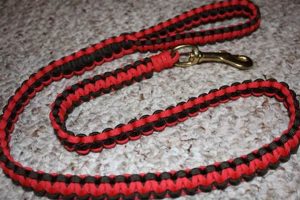A self-constructed mechanism designed to release canine sustenance represents a practical solution for automated pet feeding. These systems, ranging from simple gravity-fed containers to more complex timer-activated devices, provide a measured amount of kibble or other suitable nourishment to an animal at predetermined intervals. A common instance would be a repurposed plastic bottle inverted over a bowl, dispensing dry food as the dog consumes the existing supply.
The advantage of constructing such a device lies in its potential cost-effectiveness and customizability. Utilizing readily available materials, pet owners can create a feeding solution tailored to their animal’s specific dietary needs and feeding schedule. Historically, these homemade solutions address the challenge of providing consistent nourishment during periods of owner absence or simply to manage feeding portions effectively. The flexibility inherent in the design allows for adaptation to different dog sizes, breeds, and consumption rates, promoting healthier eating habits and mitigating overfeeding.
Subsequent sections will delve into various construction methods, material considerations, safety precautions, and design modifications that can optimize the functionality and longevity of these automated feeding apparatuses. A comprehensive evaluation of different design strategies will further illuminate the key factors in building a reliable and effective system for dispensing canine sustenance.
Tips for Optimizing a Self-Assembled Canine Alimentation Device
The following recommendations aim to improve the efficiency, safety, and longevity of a device crafted to automatically provide sustenance to canines.
Tip 1: Material Selection is Paramount: Opt for food-grade plastics or stainless steel for all components that come into direct contact with the food. This minimizes the risk of contamination and prevents the leaching of harmful chemicals into the animal’s diet.
Tip 2: Prioritize Structural Integrity: Ensure the dispenser’s construction is robust enough to withstand the animal’s interaction. Reinforce joints and seams to prevent breakage or accidental disassembly, particularly for larger or more energetic dogs.
Tip 3: Implement Portion Control Measures: Integrate a mechanism to regulate the amount of food dispensed at each interval. This can be achieved through adjustable dispensing apertures or timed release systems, thereby preventing overeating and promoting healthy weight management.
Tip 4: Design for Ease of Cleaning: Choose designs that allow for easy disassembly and cleaning. Regular maintenance is crucial to prevent the buildup of bacteria and mold, ensuring the dispenser remains hygienic and safe for canine use. Rounded corners and smooth surfaces facilitate this process.
Tip 5: Incorporate Anti-Jamming Mechanisms: Implement features that prevent food from clogging or jamming the dispensing mechanism. Sloped surfaces and wide dispensing channels can help maintain a consistent flow of kibble.
Tip 6: Emphasize Stability: A stable base is essential to prevent the dispenser from being knocked over. A wide footprint or weighted base will minimize the risk of spillage and ensure consistent operation.
Tip 7: Gradual Introduction is Key: Introduce the device to the animal gradually, allowing it to acclimate to its presence and operation. Positive reinforcement, such as rewarding the dog for approaching and interacting with the dispenser, can aid in this process.
Effective utilization of these guidelines leads to a more secure, hygienic, and dependable feeding solution. This translates to improved canine health and well-being, as well as increased convenience for the pet owner.
The subsequent analysis will focus on the long-term sustainability and potential enhancements for these types of feeding devices.
1. Material Toxicity
Material toxicity represents a critical concern in the context of self-assembled canine alimentary devices. The selection of inappropriate materials can lead to the leaching of harmful chemicals into the animal’s food, potentially resulting in adverse health effects. Certain plastics, particularly those not designated as food-grade, may contain bisphenol A (BPA) or phthalates, known endocrine disruptors. These compounds can migrate into the kibble, subsequently ingested by the dog, and accumulate in the animal’s system over time. Prolonged exposure may contribute to hormonal imbalances, developmental issues, and increased susceptibility to certain cancers. Therefore, the material composition of all components in direct contact with the food must be carefully evaluated.
The impact of material toxicity is not merely theoretical. Instances of pet food contamination due to inadequate packaging materials demonstrate the real-world consequences. While these examples often involve commercial production, the principle applies equally to homemade devices. A dispenser constructed from recycled industrial plastic, for instance, may appear functional but poses a significant health risk due to the unknown chemical composition and potential for leaching. The selection of food-grade stainless steel or specifically certified food-safe plastics (such as polypropylene) is crucial to mitigating this risk. Furthermore, the potential for abrasion or degradation of the material over time should be considered, as this can accelerate the release of potentially harmful substances.
In conclusion, a thorough understanding of material toxicity is paramount to ensuring the safety and well-being of the animal consuming food dispensed from a homemade device. Rigorous material selection, prioritizing food-grade options and avoiding potentially harmful substances, is non-negotiable. While the apparent cost-effectiveness of using alternative materials may be appealing, the potential long-term health consequences for the animal far outweigh any perceived financial savings. Prioritizing material safety safeguards the dog’s health and reflects responsible pet ownership.
2. Dispensing Accuracy
Dispensing accuracy is paramount in the design and implementation of any self-constructed canine food dispensing device. Consistent portion control directly impacts the animal’s health and well-being. Inaccurate dispensing, whether over or under-feeding, can lead to a range of health problems, including obesity, diabetes, and malnutrition. Therefore, achieving reliable and precise food delivery is a core objective.
- Mechanism Precision
The precision of the dispensing mechanism is directly correlated with accuracy. Gravity-fed systems, while simple, often lack the ability to consistently deliver the same volume of food. Devices employing timed augers or rotating dispensing wheels offer greater control. The physical tolerances of these components, such as the size and shape of the auger flights or the volume of each compartment on a dispensing wheel, must be carefully considered to minimize variation in portion size. Calibration and testing are essential to quantify and correct any inherent inaccuracies.
- Food Consistency
The physical characteristics of the food itself play a significant role in dispensing accuracy. Kibble size, shape, and density can affect the flow rate through the dispensing mechanism. Irregularly shaped kibble may cause jamming or inconsistent delivery. Using a consistent brand and type of food is crucial for maintaining predictable dispensing volumes. Furthermore, changes in ambient humidity can alter the moisture content and flow properties of the food, potentially impacting accuracy over time.
- Calibration and Adjustment
A system for calibrating and adjusting the dispensing volume is essential for long-term accuracy. This may involve adjusting the timer settings on a timed dispensing mechanism or modifying the size of the dispensing aperture on a gravity-fed system. Regular monitoring of the dispensed portion size is necessary to identify and correct any deviations. The ability to easily adjust the dispensing volume allows the owner to adapt to changes in the animal’s dietary needs or the physical properties of the food.
- Environmental Factors
External factors, such as temperature and humidity, can influence dispensing accuracy. Temperature fluctuations can affect the dimensions of the dispensing components, potentially altering the dispensing volume. High humidity can cause the kibble to absorb moisture, leading to clumping and inconsistent flow. Positioning the device in a climate-controlled environment can help minimize these effects. Regular inspection and cleaning of the dispensing mechanism are also essential to prevent the buildup of debris and maintain accurate operation.
These multifaceted considerations highlight the complexity of achieving consistent dispensing accuracy in self-constructed canine food dispensing devices. While simplicity may be appealing, more sophisticated mechanisms and careful attention to material properties, environmental factors, and calibration are often necessary to ensure the animal receives the appropriate portion size consistently. Failure to address these factors can have significant consequences for the animal’s health and well-being, underscoring the importance of prioritizing dispensing accuracy in the design and construction of these devices.
3. Structural Stability
Structural stability constitutes a foundational requirement for any self-assembled canine alimentary device. A dispenser lacking sufficient structural integrity poses a direct risk to the animal and undermines the intended functionality of automated feeding. The connection between structural stability and a do-it-yourself canine food dispenser is causal: inadequate construction techniques or improper material selection will inevitably lead to device failure. This failure can manifest as collapse under the weight of the food supply, tipping during animal interaction, or component breakage, each presenting potential hazards. An unstable dispenser may spill food, creating a mess and attracting pests, or, more seriously, collapse on the animal, causing injury.
The importance of structural stability is further illustrated by examining real-world examples of failed designs. A dispenser constructed from thin, unreinforced plastic may buckle under the pressure exerted by a full load of kibble. A device with poorly secured legs or a narrow base is prone to tipping, especially if the animal nudges or leans against it. Similarly, a dispenser relying on weak adhesives for joining components may gradually degrade over time, eventually leading to catastrophic failure. Each instance underscores the necessity of robust construction and careful attention to structural integrity. Understanding load-bearing principles, weight distribution, and material strength is crucial for a successful build.
In conclusion, the practical significance of ensuring structural stability in a self-constructed canine food dispenser cannot be overstated. It directly impacts the device’s reliability, safety, and longevity. Prioritizing sturdy materials, secure connections, and a stable base not only prevents potential hazards but also ensures the dispenser fulfills its intended purpose of providing consistent and reliable food delivery to the animal. Ignoring these structural considerations compromises the effectiveness of the device and puts the animal at risk.
4. Hygienic Maintenance
The connection between hygienic maintenance and a self-constructed canine food dispenser is a critical determinant of animal health. Neglecting regular cleaning protocols introduces several risks, most notably the proliferation of bacteria and mold within the device. These microorganisms can contaminate the kibble, leading to gastrointestinal distress, infections, or even more severe health complications for the dog. The enclosed environment of a dispenser, combined with the presence of food particles and moisture, creates an ideal breeding ground for these pathogens. The direct consequence of inadequate hygiene is a higher likelihood of illness, undermining the purpose of providing consistent nourishment. The practical significance lies in the preventive nature of hygienic maintenance, mitigating risks that directly impact the animal’s well-being and overall health.
The design and construction of the device directly influence the ease and effectiveness of hygienic maintenance. Complex designs with numerous crevices and non-removable parts present significant cleaning challenges. The choice of materials also plays a crucial role; porous materials are more susceptible to bacterial growth and harder to sanitize. A practical approach involves designing the dispenser with smooth, easily accessible surfaces and utilizing materials that can withstand frequent cleaning with appropriate disinfectants. Real-world examples, such as pet food containers recalled due to mold contamination, highlight the potential consequences of inadequate hygiene protocols. Therefore, incorporating design features that simplify cleaning and employing consistent cleaning routines are essential for safe operation.
In conclusion, the relationship between hygienic maintenance and a DIY canine food dispenser is inextricable. Proper sanitation practices are not merely an afterthought but a fundamental component of responsible design and usage. The challenges associated with maintaining a hygienic environment necessitate careful material selection and design considerations. Prioritizing ease of cleaning and implementing a regular cleaning schedule are crucial steps in safeguarding the animal’s health and preventing the proliferation of harmful microorganisms. The understanding of this link enables the construction and use of feeding devices that are both convenient and safe.
5. Animal Interaction
Animal interaction constitutes a crucial element in the context of a self-constructed canine food dispensing device. The design and implementation of such a device must account for the physical and behavioral characteristics of the animal utilizing it. Successful integration necessitates a consideration of safety, accessibility, and the potential for learned behaviors.
- Accessibility and Ergonomics
The dispenser’s design must accommodate the animal’s size and physical capabilities. Height, reach, and maneuverability are critical factors. A device positioned too high may be inaccessible, while one too low could be easily tipped over. Similarly, the dispensing mechanism should be operable without requiring excessive force or dexterity. The physical interface between the animal and the device should be intuitive and non-threatening to prevent anxiety or aversion. Ergonomic considerations prevent physical strain or injury during usage, optimizing the animal’s experience.
- Durability and Resistance to Damage
Canine interaction often involves behaviors such as chewing, scratching, and pushing. A self-constructed dispenser must be able to withstand these forces to prevent damage or destruction. Weak materials or poorly secured components pose a risk of breakage, potentially exposing the animal to small parts or sharp edges. The selection of durable materials and robust construction techniques is essential for ensuring the longevity and safety of the device. Reinforcing vulnerable areas and minimizing the presence of detachable parts can mitigate the risk of damage during normal animal interaction.
- Safety and Prevention of Ingestion
The potential for ingestion of small parts represents a significant safety concern. All components of the dispenser, particularly those accessible to the animal, must be of a size and material that prevents accidental swallowing. Sharp edges, protruding screws, or loose components should be avoided. Non-toxic materials must be used throughout to prevent poisoning in the event of ingestion. Regular inspection of the device for signs of wear or damage is crucial to identify and address potential hazards before they pose a risk to the animal.
- Behavioral Conditioning and Learning
Introducing a new feeding device may require behavioral conditioning to encourage the animal to use it effectively. Positive reinforcement, such as rewarding the animal for approaching or interacting with the dispenser, can facilitate this process. Some animals may require a gradual introduction, starting with simple interactions and progressively increasing the complexity of the task. Understanding the animal’s learning style and adapting the training approach accordingly can improve the likelihood of successful adaptation. Observational learning, where the animal learns by watching other animals use the device, can also be a valuable tool.
Consideration of animal interaction is an integral aspect of developing effective and safe DIY feeding solutions. By prioritizing accessibility, durability, safety, and behavioral conditioning, a dispenser can promote both physical well-being and cognitive engagement. Failing to address these elements increases the likelihood of complications, from minor annoyances to serious safety hazards. A thoughtful approach to this essential consideration ensures a positive and enriching experience for the animal.
Frequently Asked Questions
This section addresses common inquiries and misconceptions regarding the construction and use of homemade dog food dispensers.
Question 1: What are the primary benefits of constructing a dispenser independently versus purchasing a commercially available model?
Independent construction allows for customization tailored to a specific animal’s needs and dietary requirements. The utilization of readily available materials can reduce overall cost and provide a more environmentally sustainable approach. Furthermore, the project provides an opportunity to understand and potentially modify the design according to specific needs.
Question 2: What materials are deemed unsafe for use in direct contact with canine sustenance?
Non-food-grade plastics, especially those containing Bisphenol A (BPA) or phthalates, should be avoided. Metals prone to rust or corrosion are also unsuitable. Materials with rough surfaces or small crevices that cannot be thoroughly cleaned pose a bacterial contamination risk.
Question 3: How is portion control effectively implemented in a self-assembled dispenser?
Portion control can be achieved through various mechanisms, including timed dispensing systems, adjustable aperture sizes, or volumetric measuring devices integrated into the design. Regular calibration and monitoring are essential to ensure accurate food delivery.
Question 4: What are the key factors in ensuring the structural integrity of a homemade dispenser?
Robust materials, secure connections, and a stable base are fundamental. The design should account for the weight of the food supply and the potential for interaction from the animal. Reinforcement of vulnerable areas is recommended to prevent breakage or tipping.
Question 5: How frequently should a self-assembled dispenser be cleaned, and what cleaning agents are appropriate?
The dispenser should be cleaned at least weekly, and more frequently if food residue is visible. Hot, soapy water is generally sufficient. Avoid harsh chemicals that could leave harmful residue. Thorough rinsing and drying are essential to prevent bacterial growth.
Question 6: What safety precautions should be taken to prevent injury or accidental ingestion of parts by the animal?
All components should be securely fastened and of a size that prevents accidental swallowing. Sharp edges or protruding screws should be avoided. Regular inspection for wear or damage is crucial, and any compromised components should be promptly repaired or replaced.
These responses underscore the importance of careful planning, material selection, and maintenance when constructing a homemade feeding device. Prioritizing safety and hygiene is paramount to ensuring the animal’s well-being.
The following section will delve into advanced design concepts and explore the potential for incorporating technology into these dispensers.
Conclusion
The preceding discourse has examined the various facets of self-constructed canine feeding devices, emphasizing material selection, dispensing accuracy, structural stability, hygienic maintenance, and animal interaction. The information presented has highlighted the complexities inherent in designing and implementing such systems effectively and safely. The fabrication of a diy dog food dispenser necessitates a comprehensive understanding of these key considerations to safeguard the animal’s health and well-being.
The construction and utilization of a diy dog food dispenser demands a commitment to responsible pet ownership, prioritizing safety, hygiene, and the animal’s specific needs. Diligence in these areas will result in a practical feeding solution that contributes positively to the canine’s quality of life. The information presented serves as a foundation for informed decision-making in the creation and application of a diy dog food dispenser.







